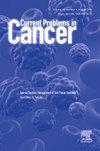超过CTS5评分:一种预测激素受体阳性和人表皮生长因子受体2阳性乳腺癌患者长期预后的新nomogram
IF 2.3
4区 医学
Q3 ONCOLOGY
引用次数: 0
摘要
背景:dhr +/HER2+乳腺癌晚期复发风险高。CTS5被广泛用于预测HR+/HER2-患者的晚期复发。本研究旨在探索CTS5在HR+/HER2+患者中的应用,并开发一种具有更强预测疗效的新模型。方法从SEER数据库中收集2010 - 2019年诊断为HR+/HER2+的乳腺癌患者26605例。主要生存结局是诊断后5年的乳腺癌特异性生存(BCSS)。计算CTS5评分。进行生存分析。Cox回归确定了重要的临床病理参数,用于构建nomogram。结果将患者分为CTS5低组(n = 10,217, 38.4%)、中组(n = 9,257, 34.8%)和高危组(n = 7,131, 26.8%)。CTS5高危亚组患者诊断时年龄较大、绝经后、TN分期和分级较高的肿瘤发生率更高(p <;0.001)。高危患者的BCSS较中低危患者差(累积危险度:BCSS分别为7.4%、3.2%和1.7%,p <;0.001)。Cox回归提示年龄、TN分期、化疗和放疗与BCSS相关(p <;0.001),而年级则没有。建立基于年龄、肿瘤大小和淋巴结的形态图。6、8、10年BCSS的ROC曲线AUC值分别为0.687、0.698、0.700。模态图显示,与CTS5相比,似然比统计值显著更高(518.9比483.8,p <;0.001)。结论我们证实了CTS5在HR+/HER2+乳腺癌中的预后价值,并开发了一种新的nomogram,与CTS5相比,CTS5对长期预后的预测能力更强。本文章由计算机程序翻译,如有差异,请以英文原文为准。
Beyond CTS5 score: A novel nomogram predicting long-term prognosis in patients with hormone receptor-positive and human epidermal growth factor receptor 2-positive breast cancer
Background
HR+/HER2+ breast cancer are exposed to high late-recurrence risk. CTS5 is widely used in predicting late recurrence of HR+/HER2- patients. This study aims to explore the application of CTS5 in HR+/HER2+ patients and develop a novel model with greater predictive efficacy.
Methods
We collect 26605 HR+/HER2+ breast cancer patients diagnosed between 2010 and 2019 from SEER database. The main survival outcome was breast cancer-specific survival (BCSS) after 5 years of diagnosis. CTS5 score was calculated. Survival analysis was performed. Cox regression identified significant clinicopathological parameters, which were used to construct a nomogram.
Results
Patients were stratified into CTS5 low- (n = 10,217, 38.4%), intermediate- (n = 9,257, 34.8%) and high-risk (n = 7,131, 26.8%) groups. Patients in CTS5 high-risk subgroup were more likely to be older at diagnosis, postmenopausal and have tumors with higher TN stage and grades (all p < 0.001). High-risk patients showed worse BCSS compared with intermediate- and low-risk patients (cumulative hazard: BCSS, 7.4%, 3.2% and 1.7%, p < 0.001). Cox regression suggested age, TN stage, chemotherapy and radiotherapy were BCSS associated (all p < 0.001) while grade wasn't. A nomogram based on age, tumor size and lymph nodes was constructed. The AUC values of the ROC curves for 6, 8, and 10-year BCSS were 0.687, 0.698, and 0.700. The nomogram demonstrated a significantly higher likelihood ratio statistic compared to CTS5 (518.9 vs. 483.8, p < 0.001).
Conclusions
We confirmed the prognostic value of CTS5 in HR+/HER2+ breast cancer and developed a new nomogram with superior predictive performance for long-term prognosis compared to CTS5.
求助全文
通过发布文献求助,成功后即可免费获取论文全文。
去求助
来源期刊

Current Problems in Cancer
医学-肿瘤学
CiteScore
5.10
自引率
0.00%
发文量
71
审稿时长
15 days
期刊介绍:
Current Problems in Cancer seeks to promote and disseminate innovative, transformative, and impactful data on patient-oriented cancer research and clinical care. Specifically, the journal''s scope is focused on reporting the results of well-designed cancer studies that influence/alter practice or identify new directions in clinical cancer research. These studies can include novel therapeutic approaches, new strategies for early diagnosis, cancer clinical trials, and supportive care, among others. Papers that focus solely on laboratory-based or basic science research are discouraged. The journal''s format also allows, on occasion, for a multi-faceted overview of a single topic via a curated selection of review articles, while also offering articles that present dynamic material that influences the oncology field.
 求助内容:
求助内容: 应助结果提醒方式:
应助结果提醒方式:


